Zirconium is a reactive metal that found its way into many different industries due to significantly positive properties such as high mechanical strength, corrosion resistance, and high-temperature stability.
However, zirconium and zirconium alloys thrive in biochemical, nuclear, aerospace and petrochemical applications and industries.
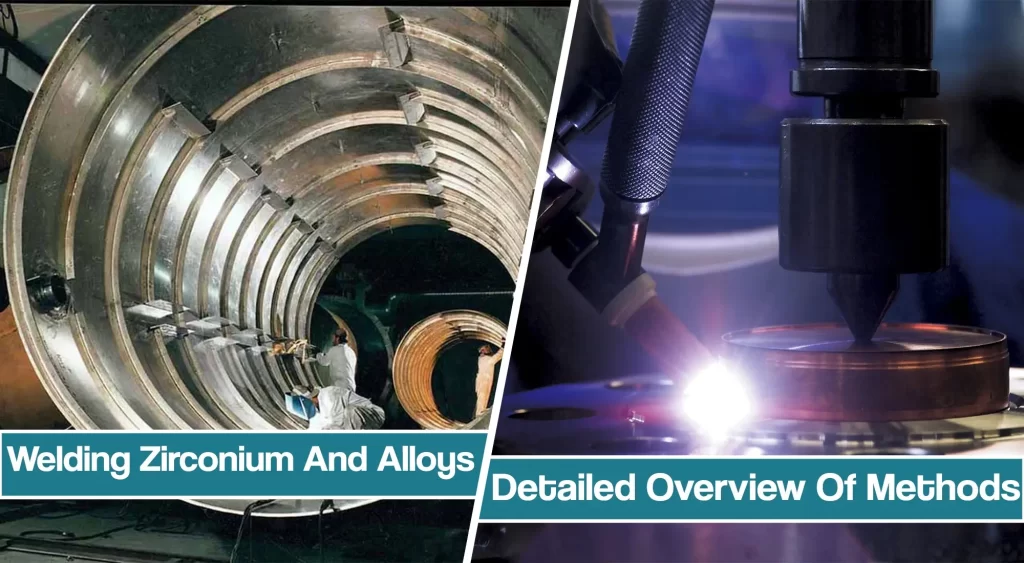
As an exotic metal that is prone to contamination by active gases such as oxygen, nitrogen, and hydrogen, welding zirconium and zirconium alloy welding can be quite challenging.
That’s why we compiled this detailed how-to guide on zirconium welding to bring the topic closer to you and help you understand the properties that make zirconium and zirconium alloys so hard to weld.
Chemical And Mechanical Properties of Zirconium and Zirconium Alloys
Zirconium is an exotic metal that can be fabricated, machined, and welded using conventional equipment.
Even though various industries recognized the positive characteristics of this metal in the past, zirconium has been seeing increased use in highly corrosive applications due to its high resistance to most mineral acids, molten salts, strong alkalis, and organic acids, and salt solutions.
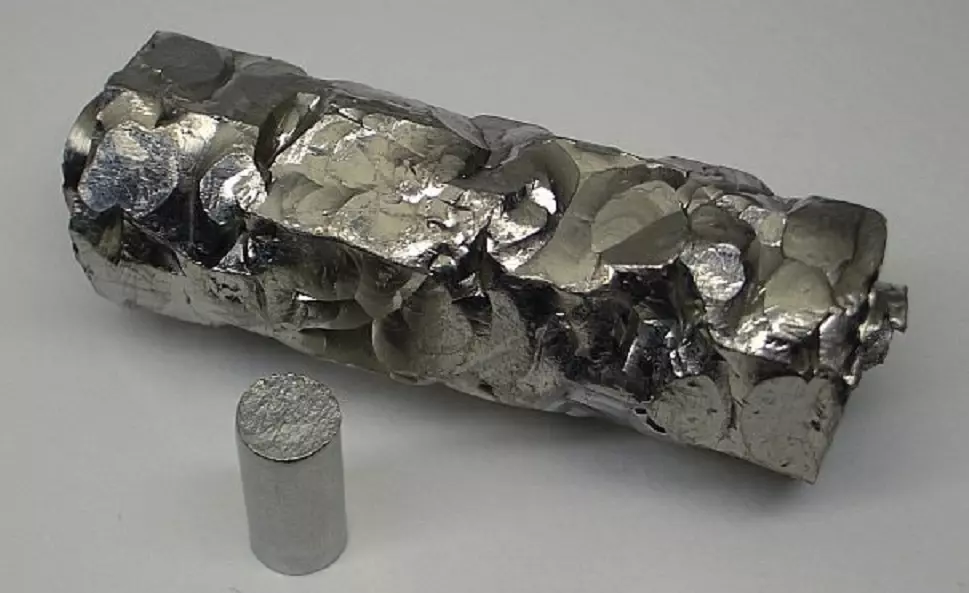
ASTM Standard Specification for Zirconium and Zirconium Alloy Ingots recognizes six different grades of zirconium alloys, but the widely used are:
- Grade R60700 (Zr 700), low oxygen, unalloyed zirconium
- Grade R60702 (Zr 702), unalloyed zirconium
- Grade R60704 (Zr 704), zirconium alloy with tin
- Grade R60705 (Zr 705), zirconium alloy with niobium content
- Grade R60706 (Zr 706), high strength, and high elongation grade.
These grades have somewhat similar physical properties, but they differ in composition. The following tables will represent the composition and properties of zirconium and different zirconium grade alloys.
| Alloy | USN | Zirconium | Hafinium | Niobium | Tin | Iron Chromium | Oxygen | Nitrogen | Carbon | Hydrogen |
|---|---|---|---|---|---|---|---|---|---|---|
| 702 | R60702 | 99.2 | 4.5 | / | / | 0.2 max | 0.16 | .025 | .05 | .005 |
| 704 | R60704 | 97.5 | 4.5 | / | 1-2 | 0.2-0.4 | 0.18 | .025 | .05 | .005 |
| 705 | R60705 | 95.5 | 4.5 | 2-3 | / | 0.2 | 0.18 | .025 | .05 | .005 |
| 706 | R60706 | 95.5 | 4.5 | 2-3 | / | 0.2 | 0.16 | .025 | .05 | .005 |
| Alloy | Yield Strength (N/mm2) | Tensile Strength (N/mm2) | Elongation (%) | Elasticity (kN/mm2) | Density (g/cm3) | Heat Capacity (J/kg) | Thermal Conductivity (W/m) |
|---|---|---|---|---|---|---|---|
| Zr700 | 205 | >380 | 16 | 99 | 6.5 | 285 | 22 |
| Zr702 | 205 | >380 | 16 | 99 | 6.5 | 285 | 22 |
| Zr704 | 250 | >420 | 14 | 95 | 6.5 | 280 | 17.1 |
| Zr705 | 380 | >580 | 16 | 95 | 6.5 | 280 | 17.1 |
Common Zirconium Alloys
While ASTM classifies zirconium alloys into six different grades, today’s industries commonly use two: Zr 702 (R60702) and Zr 705 (R60705). These are known for their corrosion resistance and decent properties, and they are the only two zirconium grades that are acknowledged by ASME Boiler Code construction.
Zr 702 is unalloyed zirconium that prevails in pressure vessels, heat exchangers, and other similar applications. However, alloying elements such as 2-3% niobium are introduced when higher strength is required. Alloying niobium results in Zr 705 grade zirconium which is used in high-strength mechanical applications such as fasteners, shafts, and tower internals.
While Zr 702 and Zr 705 are the most common zirconium alloys, Zr 702 takes an edge as a better all-around alloy. However, although Zr 705 offers higher strength, it requires a 14-day stress-relief period. Even though weld metal cools, if stress relief is ignored, anneal or delayed hydride cracking can occur.
Zirconium Welding – Issues, Preparation, and Methods
The biggest issue with zirconium welding is the fact weld metal is susceptible to contamination by active gases such as oxygen, nitrogen, and hydrogen. Therefore, joining zirconium shouldn’t be done before cleaning the surface, weld joint, and welding wire.
Another condition for successful welding of zirconium alloy is the clean atmosphere. A clean atmosphere is provided by inert gas shielding, most commonly welding-grade argon. But that’s not all; shielding gas post flow is most widely required. Shielding gas should protect heat affected zone until it cools from the melting point of 3,334 F to less than 600 degrees.
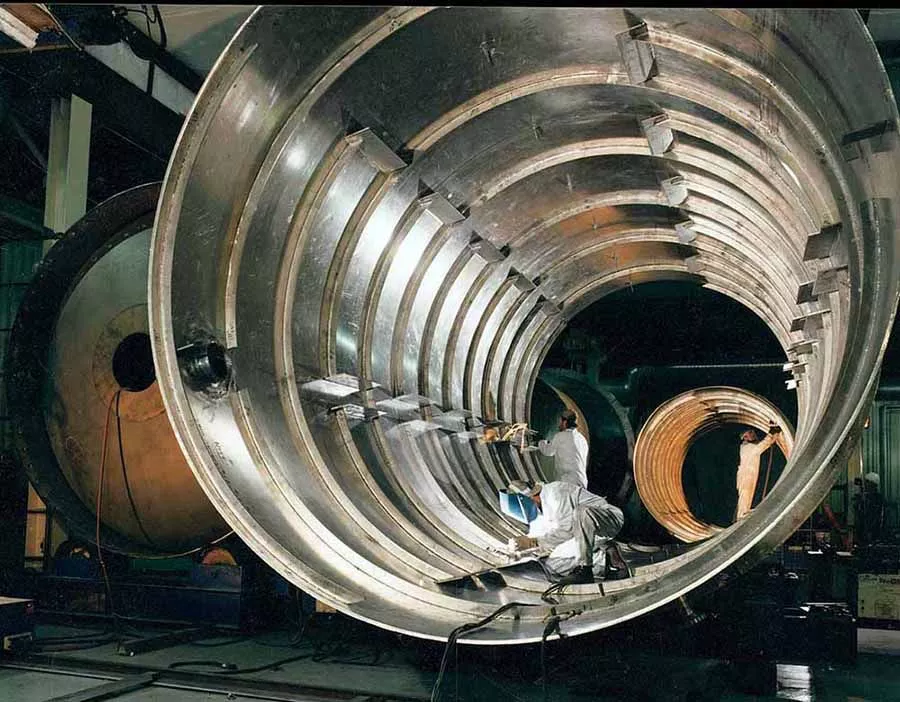
Since cleanliness is crucial, the typical go-to zirconium welding method is TIG welding (GTAW). However, in specific applications, welding of zirconium alloys can be done by electron beam welding, fusion welding, resistance welding, or plasma arc welding process.
Weld Preparation And Cleaning
As we noted, weld preparation and cleaning is crucial for successful zirconium alloy welding. Weldin preparation includes removing all impurities from the weld area. A matching or stainless steel brush can help you remove any possible contamination, and afterward, you can use solvents to degrease the parts.
Contamination of the zirconium can occur fast, so ensure you weld parts soon after cleaning them. If you have to delay the welding after the cleaning, you should ensure zirconium alloys are protected from dust and other possible contaminants in the workshop. If your zirconium weld preparation includes grinding, make sure you use dedicated aluminum oxide or silicon carbide wheels and abrasives.
Shielding Gas Choice
Since zirconium is one of the reactive metals, you will have to protect the weld zone by using the shielding gas or weld in the vacuum atmosphere.
Using inert gas shielding with high gas purity of argon, helium, or a mixture of these two protects the molten puddle from moisture, oxygen, and nitrogen contamination.
In addition, you will get excellent corrosion performance by ensuring clean welds and a clean atmosphere during welding.
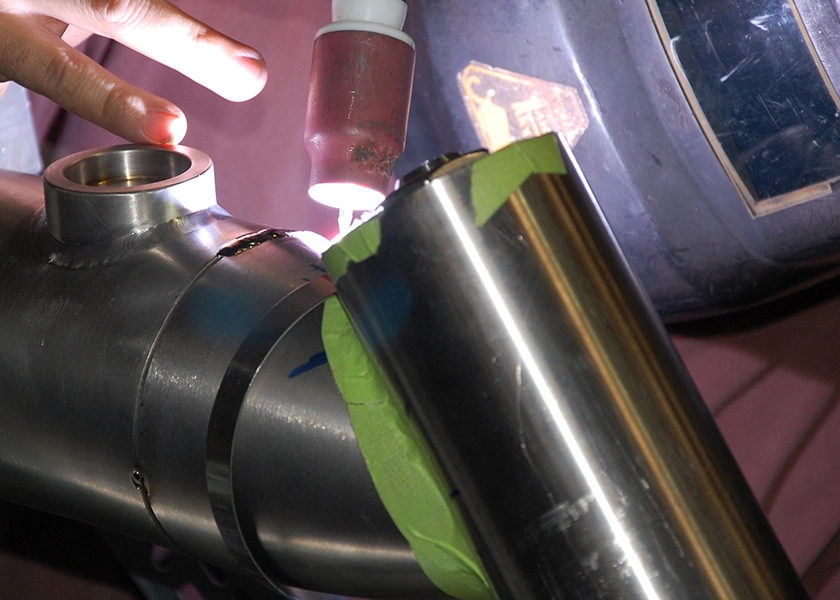
Besides shielding, you will also have to ensure purge gas when gas tungsten arc welding. Both shielding and purging can be done with welding-grade argon. Most commonly, that’s argon with 99.998 percent purity. Manufacturers should also provide less than five parts per million (PPM) of oxygen, moisture, or total hydrocarbons. Starting purge rates are 20 to 50 CFH, but you can reduce them to 5 to 20 CFH once an inert atmosphere is achieved.
In addition to pure inert gas, argon/helium mixtures can take care of backup shielding and purging. In this mixture, argon grants a stable arc while helium’s low-density purges blind spaces.
On the other hand, electron beam welding can be performed in a vacuum. As a result, there is no risk of contamination, but that’s commonly used in industrial applications, such as chemical industry, pressure vessels, and heat exchangers.
Another essential shielding component when using TIG (GTAW) welding is a gas lens or gas cup. The gas lens provides unmatched shielding of the weld root, as they minimize turbulence and offer a uniform blanket of gas protection.
Trailing Devices That Improve Shielding
To improve shielding and make sure there is low to no risk of any contamination, you can employ trailing devices for backup shielding. These prevent velocities at the gas inlet that can entrain air or cause contamination.
Trailing devices usually use 7 to 10 cubic feet per hour (CFH) per square inch of surface and ensure excellent arc stability and protection in the heat-affected zone. However, keep in mind that excessive flow rates can cause turbulence, causing oxygen to enter the weld zone.
Filler Metal and Tungsten For Gas Tungsten Arc Welding Of Zirconium
Like any other welding type and method, when welding zirconium, you should match the filler metal to the base metal or zirconium alloy grade.
The American Welding Society (AWS) classifies zirconium filler metal under the A 5.24 code. This publication is named “Zirconium and Zirconium Alloy Bare Welding Rods Electrodes,” and the most common fillers are given in the table below.
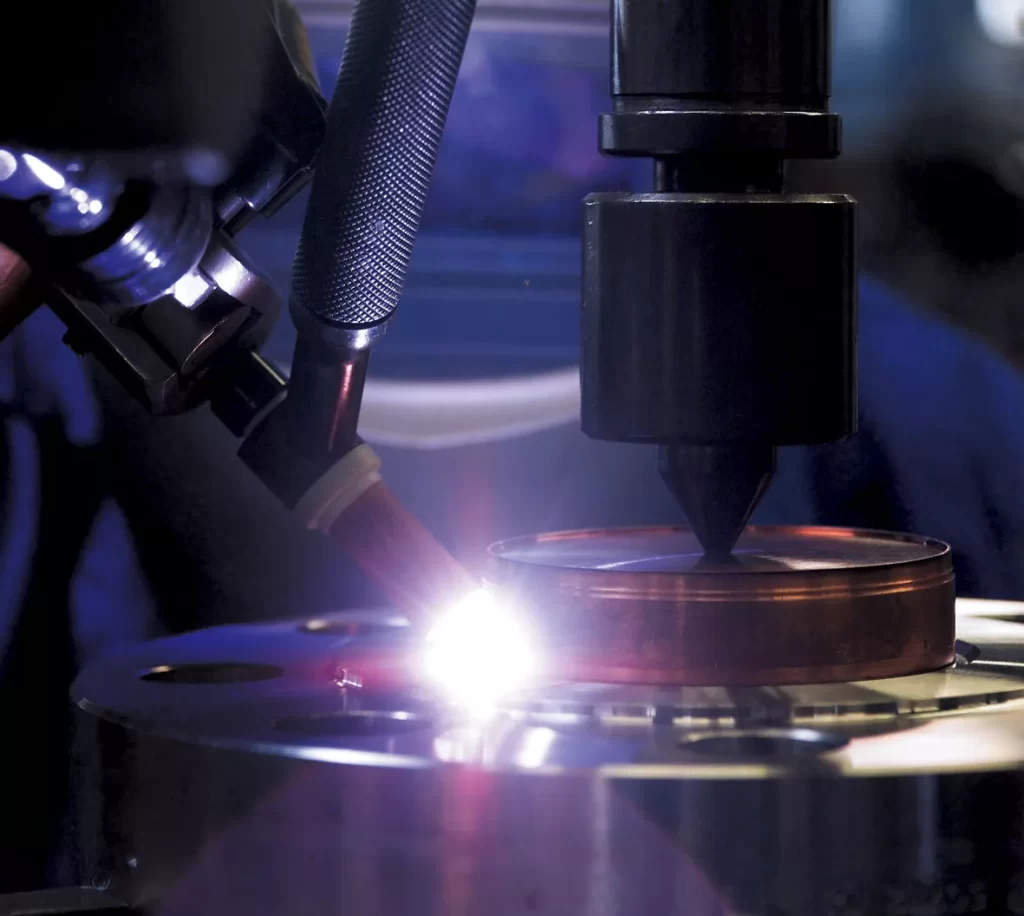
| AWS Classification | UNS | Zirconium | Hafinium | Iron | Tin | Oxygen | Hydrogen | Nitrogen | Carbon | Niobium |
|---|---|---|---|---|---|---|---|---|---|---|
| Er Zr2 | R60702 | 99.9 | 4.5 | 0.20 | / | 0.11-0.15 | .005 | .015 | .03 | / |
| Er Zr3 | R60704 | 97.5 | 4.5 | 0.20-0.30 | 1.-2 | 0.11-0.16 | .005 | .015 | .03 | / |
| Er Zr4 | R60705 | 95.5 | 4.5 | 0.20 | / | 0.11-0.16 | .005 | .015 | .03 | 2-3 |
Depending on the applications, you can use 2 percent thoriated tungsten electrodes (AWS EW Th-2), Lanthanted (EW La-1), or Zirconated (Ew Zr-1) tungsten. Thoriated tungsten (EW Th-2) is a common go-to choice for various applications. On the other hand, other types, such as EW Zr-1 tungsten, are sometimes used for higher-current applications.
For tungsten preparation, 20-30% taper with a blunt end will do the work. Larger tungsten minimizes the risk of overheating and tungsten inclusions.
Zirconium Alloy Welding Machines And Settings
TIG welding of zirconium is typically accomplished with a direct current. The power supply (TIG welding machine) is connected to a straight-polarity, but a high-frequency arc start is required to avoid tungsten contamination.
You will need perfect control over the entire welding process to achieve the best results when welding zirconium. You can accomplish that by choosing a TIG welder that offers upslope and downslope controls and is compatible with a foot pedal. Commonly used TIG welding zirconium settings are shown in the table below.
| Wire Diameter | 1/16 | 3/32 | 1/8 |
|---|---|---|---|
| Current (A) | 100-150 | 125-175 | 150-175 |
| Voltage | 14-16 | 13-15 | 13-15 |
| Speed | 4-8 | 4-8 | 4-8 |
| Torch Gas (CFH) | 15 | 15 | 15 |
| Trailing Gas | 30-40 | 30-40 | 30-40 |
| Backup gas | As required | As required | As required |
Heat Control During Welding
Welding zirconium alloys usually doesn’t require preheating, but you can heat it up to 100 to 140 degrees F when the shop temperature is low or when there is moisture in the air or on the workpieces.
Controlling the heat in the heat-affected zone or interpass temperatures is not essential for mechanical properties, but it can affect the color and overall aesthetics of the weld. If the interpass temperature in heat-affected zones is high, the surface will change color.
Final Results And Thoughts
You will get decent zirconium welding results once you employed all precautions, cleaned the surface, and ensured adequate shielding. The weld can be visually inspected to look for defects, but in industrial applications, further testing is compiled.
Surface color can be an indicator that shielding was effective. For example, a shiny metallic silver color can tell you that primary shielding, trailing, and secondary shielding was effective. On the other hand, color is usually caused by light refracted into the transparent surface oxide. As the result, oxidation can affect the corrosion resistance properties that zirconium alloys are primarily used for. A white/buff loose oxide layer results from the total failure of primary or secondary shielding.

Further tests, such as the transient reactor test, quality control, or hardness test, can tell you more about the physical properties of the weld metal. The hardness of the weld should achieve 30 points Brinell or more above base metal hardness. In addition, the bend radius should be 5 times the material thickness.
Resources:
- https://www.thefabricator.com/tubepipejournal/article/tubepipefabrication/welding-zirconium-and-zirconium-alloys-part-i
- https://www.huntingdonfusion.com/index.php/de/technical-support/white-papers-40017/3801-welding-of-zirconium-and-its-alloys
- https://steelforge.com/literature/ferrousnon-ferrous-materials-textbook/non-ferrous-metals/zirconium/
- https://dl.asminternational.org/handbooks/edited-volume/61/chapter-abstract/720575/Welding-of-Zirconium-Alloys?redirectedFrom=fulltext
- https://www.researchgate.net/publication/294693732_Welding_of_Zirconium_alloys





